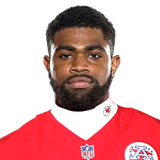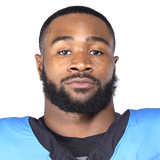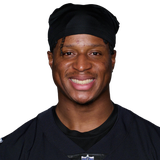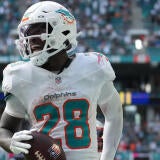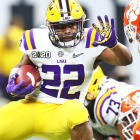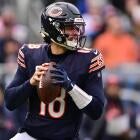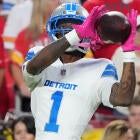2020 Fantasy Football Running Back Breakouts: Miles Sanders, Kenyan Drake, Joe Mixon ready for the next step
Want to find next year's first-round picks? Our breakout running backs will be stars in 2020.
Running back is the most opportunity-driven position in Fantasy football, which means if you're looking for breakouts, you should be looking for players who are about to get a big opportunity.
Like Clyde Edwards-Helaire, who finds himself likely alone at the top of the Chiefs depth chart after Damien Williams opted out of the season. Or Miles Sanders, who emerged as the Eagles go-to back in the second half of his rookie season and who seems primed for a full season in that role after an offseason that saw the Eagles largely stand pat in the wake of Jordan Howard's departure. If either of those guys gets the workload we're hoping for, their first-round prices may not seem high enough by season's end.
But they aren't alone, by any means. Here, we've got seven breakout running backs from the Fantasy Football Today team, and it is unsurprisingly loaded with young backs looking to take on the every-down role and prove they can be dominant. As part of our RB preview week at CBS Fantasy we've already taken a look at the state of the position, a comprehensive breakdown of the position, a look at where ADP stands right now, and updated tiers and strategies, and now we're looking sleepers, breakouts, and busts. But, before we get to who Jamey Eisenberg, Dave Richard, Heath Cummings, and Ben Gretch like, here are some of my favorite breakout candidates they didn't mention:
- David Johnson: This one ultimately comes down to this: I don't think David Johnson is worse than Carlos Hyde, who rushed for nearly 1,100 yards and had six touchdowns. Johnson has showed he's still a dynamic playmaker in the passing game the last few seasons, so if he can add 40-50 catches to what Hyde managed on the ground, it's actually not that hard to get him close to the top-five at the position.
- Kareem Hunt: This one comes down to opportunity that Hunt doesn't have yet, but what I like about drafting Hunt is he showed plenty of value even splitting time with Nick Chubb in 2019; Hunt was 26th in Fantasy points per game last season. He'll be a viable starter if Chubb is in the lineup, but he can be a legitimate No. 1 contender if anything happens to Chubb. Given the attrition rate at running back, it's not that long of a shot.
- David Montgomery: If you're rolling your eyes at me picking a pair of running backs who have already had elite seasons in the past, then how about one of the bigger disappointments in Fantasy from a year ago. In keeping with my "Well, things can't be worse!" theory of the Bears offense in 2020, I'm expecting a breakout from Montgomery. His inefficiency in 2019 was a problem, but I actually liked the way the Bears used him as a pass-catcher, as Montgomery had the sixth-most air yards among all running backs on his 35 targets. They didn't just dump it off to him, they looked for him down the field from time to time, and that's one way to create some sneaky value. If he can get his yards per carry up above 4.0 and hits on a few more of those receptions, Montgomery has a chance to be a legitimate must-start player. Hey, he can't be worse, right?
Let's. Bleeping. Go. I'm beyond excited about Edwards-Helaire landing in Kansas City, and I can't wait to draft him as early as No. 6 overall in all leagues. He'll be the guy this year, for better or worse, that I have on all of my Fantasy teams. With Williams opting out over concerns related to COVID-19, the sky's the limit for Edwards-Helaire. Andy Reid has already said Edwards-Helaire can be better than Brian Westbrook, who was a star for Reid during his tenure in Philadelphia. Reid also has gotten tremendous production from other young running backs before, including LeSean McCoy with the Eagles and Kareem Hunt with the Chiefs. In fact, Hunt led the NFL in rushing as a rookie in 2017. I doubt we see that from Edwards-Helaire, but he was a star in college in 2019 with 1,867 total yards and 17 total touchdowns, including 55 receptions. Patrick Mahomes is going to love playing with Edwards-Helaire, and Reid will maximize his talent. He should be awesome as a rookie in 2020, and he's someone to covet on Draft Day.
| ||||||||||||||||||||
The 2019 campaign was a tale of two halves for Mixon. In the first eight games, when the Bengals were likely trying to figure out new coach Zac Taylor and deal with life without A.J. Green (ankle), Mixon struggled, averaging just 9.4 PPR points per game. He also battled an ankle injury. But after Cincinnati's bye in Week 9, things changed for Mixon. He closed the season averaging 17.4 PPR points per game, and had at least 136 rushing yards in three of his final four outings. He also had at least three catches in three of his final five games, and I'm expecting that guy to show up every week this year. The Bengals could have some growing pains with a rookie quarterback in Joe Burrow, but Taylor should continue to feature Mixon, who had at least 23 total touches in five of his final eight games. And the healthy return of offensive tackle Jonah Williams (shoulder) should help as well. Mixon is worth drafting in the back end of Round 1 in all leagues, and he has top-five potential in 2020.
| ||||||||||||||||||||
Since Doug Pederson took over the Eagles, only one running back on the team has accumulated over 1,000 total yards in a season. That would be Sanders, who also has the most 100-total-yard games of any Eagles running back in Pederson's four years, all coming in his rookie year. And he's supposed to split time like the rest of the mediocre runners who preceded him in Philly? Yeah, right. Running backs coach Duce Staley said in early August that he's excited to hand Sanders "the full load" and won't monitor his touches. There is realistic 1,500-total-yard potential here, especially considering Sanders' receiving prowess and the improved Eagles receiving corps forcing defenses to play off the snap. I'm expecting Sanders to build on an already impressive rookie season.
| ||||||||||||||||||||
Last offseason, Jones put on 12 pounds of muscle and worked on his receiving skills while ignoring his pass protection work. He improved, totaling just over 1,033 yards on 203 touches with six touchdowns all coming from inside the 10-yard line, but he also was a negative in pass protection. So what did he do this offseason? Put on seven more pounds of muscle and worked on his pass pro every day, per his trainer (sometimes twice a day). Keeping Tom Brady protected is a big deal, and if Jones gets the chance to do it, he'll effectively be a three-down back with potential for over 250 touches. He's the most explosive and physical running back on the Bucs roster — if he gets the chance to prove he's the most versatile and the best pass blocker too, then he'll put together a monster third season. Round 6 is the sweet spot for him.
| ||||||||||||||||||||
This may very well be the third consecutive year I've listed Kenyan Drake in this column; for what it's worth, we're counting last year as a win. After floundering in Miami for the first half of the season, Drake was dealt to Arizona and took off like a rocket ship. In half a season with the Cardinals he totaled 814 yards and eight touchdowns. He averaged 18.9 touches per game and ranked as the No. 4 back in PPR from Week 9 forward. How's that for upside? It's not fair to expect Drake to double that production, but with David Johnson gone, it's pretty clear Drake should be viewed as the feature back in an offense we expect to be improved. Drake projects as a top-10 back with upside beyond that.
| ||||||||||||||||||||
Just a small bump in targets could make Jacobs a borderline top-five back in 2020. As a rookie he averaged 18.6 carries per game and nearly 5 yards per carry. That type of production doesn't need much from the passing game to boost it to elite, but Jacobs did almost nothing. While he did average an acceptable 6.1 yards per target, he barely saw two targets per game. The nice thing is that's not the only way Jacobs could break out. He could also have a Derrick Henry like season with good touchdown fortune and a 16-game season. The Raiders made a lot of additions to this passing game which could help Jacobs approach the touchdown production of the other workhorse backs from 2019. He was on pace for 297 carries last year, and the only four backs that topped 280 last year averaged 12.75 rushing touchdowns between them.
| ||||||||||||||||||||
Sanders is a polarizing player, and there are two schools of thought on him. One buys into his upside as a 2019 second-round pick who exploded to close his rookie season; the other looks at Doug Pederson's committee tendencies and often cites things like Sanders' apparently poor tape running between the tackles to argue he's being overdrafted. I fall into the first category for a few reasons. First, between the tackles rushing efficiency is not something that overly concerns me, especially for young, dual threat running backs. It was once the supposed knock on Christian McCaffrey, and the concerns of touchdown production ignore the reality that short-yardage scoring is typically just a reflection of short-yardage opportunities, which can themselves be heavily influenced by how good an offense is. But that's not the only comparison we can draw to McCaffrey. Entering his second season, McCaffrey was still undervalued despite Carolina moving on from Jonathan Stewart and only adding C.J. Anderson as a low-cost free agent after the NFL Draft. Sanders is in the exact same position, except the anticipated late-offseason RB addition hasn't even come, and at this point may not. Even if it does, the Eagles, like the Panthers in 2018, have already signaled — and lately, they've outright said! — they are more than comfortable turning over their backfield to their young, dynamic sophomore. Now I don't think Sanders is on the same level as McCaffrey in terms of talent or even necessarily opportunity — the Eagles showed they love Sanders in the passing game in 2019, but his 50 rookie-year catches are a far cry from McCaffrey's 80 in his own rookie season. But many of the same factors that led to McCaffrey's 2018 ascension exist, and Sanders has the potential to start racking up gaudy High-Value Touch (HVT) numbers starting in 2020.
| ||||||||||||||||||||
There are reasons to be wary of Taylor. For starters, he's in a crowded backfield, and he doesn't come cheap in drafts. There are also fumbling issues and questions about his receiving production that follow him from college. But the case for Taylor is simple — his upside is a top-five back in the league immediately. Some discount Taylor averaging more than 2,000 rushing yards per season across three years at Wisconsin as a product of situation. But when he ran a 4.39 at 226 pounds, his athleticism was impossible to write off. The question is whether Taylor can produce immediately alongside productive veteran Marlon Mack and pass-catching specialist Nyheim Hines. But committees can be fruitful for multiple players if the situation is right, and this one is perfect. New quarterback Philip Rivers has carried a massive RB target rate throughout most of his career. The Colts have a soft schedule and elite offensive line, setting them up to generate tons of both High-Value Touches and game-script-induced low-value touches as well. If there's enough opportunity and production to go around, Taylor's breakout potential is something akin to Adrian Peterson's rookie season. In 2007, incumbent Chester Taylor was coming off a 1,500-yard season and still posted another 1,100 yards — but Peterson burst onto the scene with 1,600 of his own. The top picks in your Fantasy Football draft are almost certainly going to go to running backs, and for good reason. The combination of touchdown potential and touch volume makes them the most valuable assets in the game, and ending up with an elite back tends to go a long way toward making your roster a contender.
| ||||||||||||||||||||


